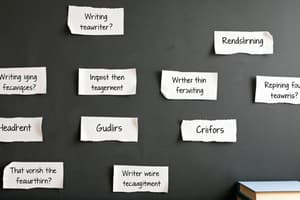Podcast
Questions and Answers
What is a key benefit of using outlining strategies in writing?
What is a key benefit of using outlining strategies in writing?
- Adding color to make the text visually appealing
- Creating a sequential order to guide the writing process (correct)
- Using symbols to represent different ideas
- Highlighting important information with bold fonts
Which outlining format involves a hierarchical arrangement of subheadings under larger headings?
Which outlining format involves a hierarchical arrangement of subheadings under larger headings?
- Organic outline
- Web outline
- Rhetorical outline
- Classical outline (correct)
What is the purpose of using primary sources in research?
What is the purpose of using primary sources in research?
- Engaging in direct conversations with experts
- Providing peer-reviewed articles
- Accessing original documents and firsthand accounts (correct)
- Analyzing previous research works
Which method is effective for expanding your knowledge base through research?
Which method is effective for expanding your knowledge base through research?
What does storyboarding aim to visually represent?
What does storyboarding aim to visually represent?
Which technique helps writers organize their thoughts and narrative elements effectively?
Which technique helps writers organize their thoughts and narrative elements effectively?
What is the primary purpose of pre-writing techniques?
What is the primary purpose of pre-writing techniques?
Which brainstorming technique involves writing continuously without stopping, editing, or worrying about grammar?
Which brainstorming technique involves writing continuously without stopping, editing, or worrying about grammar?
How does mind mapping help in structuring compositions?
How does mind mapping help in structuring compositions?
Which outlining technique involves organizing brainstormed ideas into categories?
Which outlining technique involves organizing brainstormed ideas into categories?
What is a key benefit of researching as a pre-writing technique?
What is a key benefit of researching as a pre-writing technique?
In storyboarding, what does connecting seemingly unrelated ideas aim to achieve?
In storyboarding, what does connecting seemingly unrelated ideas aim to achieve?
Flashcards are hidden until you start studying
Study Notes
Pre-Writing Techniques
Pre-writing is an integral part of writing, helping you gather ideas before putting pen to paper. There are several techniques that can aid in this process, including brainstorming, mind mapping, outlining, researching, and storyboarding. Each approach has its own benefits and can help writers create clearer, more focused compositions.
Brainstorming Techniques
Brainstorming is the act of generating many ideas quickly without evaluating them critically. This method encourages creative thinking and helps you overcome writer's block by generating numerous themes and concepts. Some popular brainstorming techniques include:
- Freewriting: Write continuously for a set amount of time without stopping, editing, or worrying about grammar.
- Listing: Create a list of topics, themes, or keywords related to the piece you're writing.
- Questioning: Formulate questions that stimulate creative thinking and generate fresh ideas.
- Clustering and categorizing: Organize your brainstormed ideas into categories.
- Associating: Connect seemingly unrelated ideas to foster creativity.
Mind Mapping
Mind mapping involves visually representing connections between ideas, making complex topics more accessible. By arranging ideas around a central concept, mind maps can reveal relationships and dependencies that aid in structuring your composition. Techniques for mind mapping include:
- Using words or images to represent ideas.
- Connecting ideas with lines indicating relationships.
- Adding color and symbols to highlight important information.
Outlining Strategies
Outlines serve as roadmaps for your writing project. By breaking down ideas into a sequential order, outlining strategies can help guide your writing process. Popular outline formats include:
- Classical outline: A hierarchical arrangement of subheadings under larger headings.
- Web outline: A tree-like diagram showing how ideas branch into increasingly detailed topics.
- Rhetorical outline: Structured according to the rhetorical appeals of ethos, pathos, and logos.
Researching Methods
Research is crucial for factual accuracy and expanding your knowledge base. Effective research methods include:
- Primary sources: Original works, like documents, recordings, or firsthand accounts of events.
- Secondary sources: Works that analyze primary sources or synthesize previous research.
- Library databases: Provide peer-reviewed articles, books, and other high-quality sources.
- Internet searches: Google Scholar, JSTOR, and similar platforms offer scholarly literature.
- Interviews: Direct conversations with experts or individuals involved in the topic.
Storyboarding
Storyboards are visual representations of your story's plot, characters, settings, and themes. They can be particularly useful for creative writing, helping you organize your narrative elements and map out the story's structure. Techniques for storyboarding include:
- Narrative arc: Determine the beginning, rising action, climax, falling action, and resolution.
- Character development: Show your characters growing or changing throughout the story.
- Scene construction: Break down your story into scenes and arrange them in a logical order.
In conclusion, pre-writing techniques such as brainstorming, mind mapping, outlining, researching, and storyboarding can significantly enhance the writing process. By using these strategies, writers can generate ideas, organize thoughts, and plan their compositions more effectively.
Studying That Suits You
Use AI to generate personalized quizzes and flashcards to suit your learning preferences.




